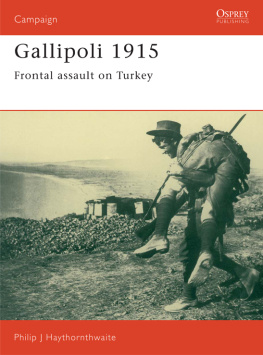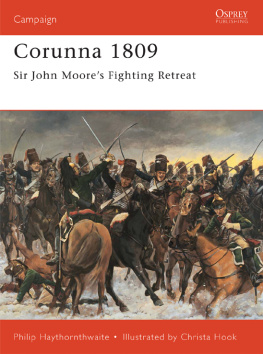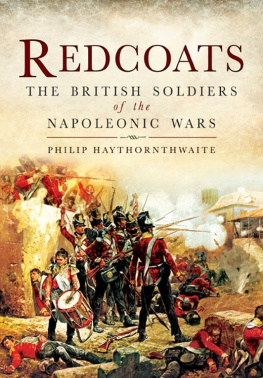First published in Great Britain in 2016 by
Pen & Sword Military
an imprint of
Pen & Sword Books Ltd
47 Church Street
Barnsley
South Yorkshire
S70 2AS
Copyright Philip J. Haythornthwaite 2016
ISBN: 978 1 78159 102 4
PDF ISBN: 978 1 47388 090 0
EPUB ISBN: 978 1 47388 089 4
PRC ISBN: 978 1 47388 088 7
The right of Philip J. Haythornthwaite to be identified as the Author of
this Work has been asserted by him in accordance with the Copyright,
Designs and Patents Act 1988.
A CIP catalogue record for this book is available from the British
Library
All rights reserved. No part of this book may be reproduced or
transmitted in any form or by any means, electronic or mechanical
including photocopying, recording or by any information storage and
retrieval system, without permission from the Publisher in writing.
Typeset in Ehrhardt by
Mac Style Ltd, Bridlington, East Yorkshire
Printed and bound in the UK by CPI Group (UK) Ltd,
Croydon, CRO 4YY
Pen & Sword Books Ltd incorporates the imprints of Pen & Sword
Archaeology, Atlas, Aviation, Battleground, Discovery, Family
History, History, Maritime, Military, Naval, Politics, Railways, Select,
Transport, True Crime, and Fiction, Frontline Books, Leo Cooper,
Praetorian Press, Seaforth Publishing and Wharncliffe.
For a complete list of Pen & Sword titles please contact
PEN & SWORD BOOKS LIMITED
47 Church Street, Barnsley, South Yorkshire, S70 2AS, England
E-mail:
Website: www.pen-and-sword.co.uk
Contents
Authors Note and Acknowledgements
In general it has been found practical to use footnotes largely to identify the sources of quotations; further references appear in the bibliography.
The author extends especial thanks to: Derek Green, Dr John A. Hall, Alan Harrison, and Dennis Sully.
Old Boney has broken out again
(how news of Napoleons return was announced)
The 1815 Campaign
To the members of the Duke of Wellingtons army stationed in and around the Belgian city of Brussels, Thursday, 15 June 1815 began as an unexceptional day. Since the return of Napoleon to France some fourteen weeks earlier, there had been the expectation of a renewal of the war that had ended with his abdication in the previous year, but it was not imagined that hostilities were imminent. The Thursday was thus a very ordinary day: for the troops some drills, some exercise, but time for both officers and soldiers to spend relaxing hours amid a friendly population in a handsome city. Probably the greatest sense of anticipation was on the part of the most prominent members of society, both military and many of the civilian tourists enjoying a holiday in Brussels, who looked forward to the grand ball to be given that night by a leading society hostess, the Duchess of Richmond.

Charlotte, Duchess of Richmond, who hosted the ball on the eve of the campaign Byrons sound of revelry by night and whose connection to the 5th Division lay with her family association with the 92nd Highlanders: she was the daughter of the 4th Duke of Gordon, whose name was carried by the regiment, and her brother had been its colonel until 1806.
The Duke of Wellington portrayed shortly after the Waterloo campaign. (Engraving after Sir Thomas Lawrence)
Sir William Howe De Lancey, Wellingtons deputy quartermaster general in the Waterloo campaign and his chief of staff. De Lancey played a crucial role in the administration of the army and in the issuing of orders; he was mortally wounded at Wellingtons side at Waterloo.
Among those invited to the ball was Wellingtons chief of staff, Sir William De Lancey, with his young bride of ten weeks, Magdalene, and so relaxed was the atmosphere that he spent the day regaling her with stories of his career until, somewhat unwillingly, he left her to keep a dinner engagement with Wellingtons friend, the Spanish general Miguel Alava. In the late afternoon the peace was shattered by the arrival of an aide-de-camp who asked urgently for De Lancey; Magdalene directed him to Alavas quarters and moments later saw her husband pelting up the street on the ADCs horse to Wellingtons lodgings. Leaving the horse in the street he ran inside with dire news: unexpectedly, Napoleon was advancing at speed. Against all expectations the campaign had begun, with the early advantage entirely in Napoleons favour.
In the spring of 1815 Europes leading statesmen were assembled in Vienna for the congress that was intended to resolve the problems of the Continent following the defeat of Napoleon in the previous year. The ex-emperor of the French had been consigned to the tiny Mediterranean island of Elba, but smarting at his fate he had resolved to risk all in an attempt to regain his previous throne. His return to France was greeted with enthusiasm by a population disillusioned with the restored Bourbon monarchy that had replaced him, and once again he posed an acute military threat to the nations that had collaborated in his overthrow in 1814. These allied states were in no mood for compromise and resolved to defeat him again, but the only troops immediately to hand were those stationed in the Netherlands, the presence of which determined Napoleons strategy: rather than await an invasion of France by overwhelming numbers of enemy forces, he planned to take the offensive himself, achieve a brisk victory over the allied troops in the Netherlands and then negotiate from a position of strength. His plan precipitated the last, climactic campaign of the Napoleonic Wars.
Two allied armies were present in the Netherlands: a Prussian force under the aged but irrepressible Gebhard Leberecht von Blcher, Prince of Wahlstdt, and a very mixed army of contingents supplied by Britain, the Netherlands, Hanover, Brunswick and Nassau. Its command was entrusted to the greatest British general of the age, Arthur Wellesley, 1st Duke of Wellington, whose victory in the Peninsular War had helped undermine Napoleon in the years leading to his abdication. Wellington had been atVienna, but arrived in Belgium to lead an army of varied quality and experience; his well-known comment was that I have got an infamous army, very weak and ill-equipped, and a very inexperienced staff. Under such circumstances, the presence of hardened troops and experienced commanders would be of vital significance. In no formation were these qualities to be more relevant than in what was to become the 5th Division of his army: Pictons Division.
The Most Complete Machine
(Wellingtons description of his Peninsular army)
The Divisional System
The organization adopted by the Duke of Wellington for the 1815 campaign was a system that had become fairly universal, his version of which had been perfected during the Peninsular War. Its primary component element was the division.
Although the principal element for manoeuvre was the infantry battalion or cavalry regiment, it had long been recognized that orders and supplies could be delivered more effectively when two or more such units were associated under a unified command. This was the origin of the brigade, in which two or more battalions or regiments were associated on an often permanent basis, marching, living and fighting together under the leadership of a general officer, most commonly a major general or one who acted temporarily in his stead. In British service the brigade had remained the primary organizational structure in the early stages of the French Revolutionary and Napoleonic wars, partly because the forces employed were originally not sufficiently numerous to require anything more sophisticated. Two or more brigades might act together, usually led by the senior of the brigade commanders, sometimes styled columns, but these were employed mostly for specific operations without any permanence in the organization. This had been the case in the Netherlands campaigns of 179394 and 1799, and in Egypt in 1801, and in the latter case there was a theoretical arrangement into lines of two or three brigades each. This system worked well enough when armies were sufficiently small for the general in overall command to direct movements and oversee affairs in person; but as the numbers and scope of operations increased, a different organization became essential.














